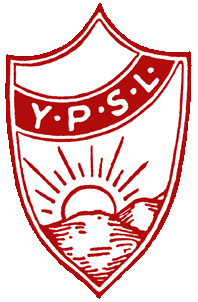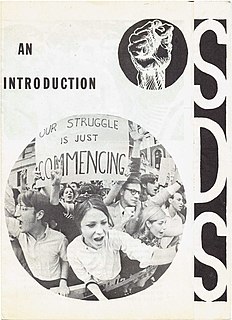The Port Huron Statement is a 1962 political manifesto of the American student activist movement Students for a Democratic Society (SDS). It was written by SDS members, and completed on June 15, 1962, at a United Auto Workers (UAW) retreat outside of Port Huron, Michigan, for the group's first national convention. Under Walter Reuther's leadership, the UAW paid for a range of expenses for the 1962 convention, including use of the UAW summer retreat in Port Huron.
Peace Action is a peace organization whose focus is on preventing the deployment of nuclear weapons in space, thwarting weapons sales to countries with human rights violations, and promoting a new United States foreign policy based on common security and peaceful resolution to international conflicts.

Student activism or campus activism is work by students to cause political, environmental, economic, or social change. Although often focused on schools, curriculum, and educational funding, student groups have influenced greater political events.
The Committee for Non-Violent Action (CNVA) was an American anti-war group, formed in 1957 to resist the US government's program of nuclear weapons testing. It was one of the first organizations to employ nonviolent direct action to protest against the nuclear arms race.

Peace News (PN) is a pacifist magazine first published on 6 June 1936 to serve the peace movement in the United Kingdom. From later in 1936 to April 1961 it was the official paper of the Peace Pledge Union (PPU), and from 1990 to 2004 was co-published with War Resisters' International.

Women Strike for Peace was a women's peace activist group in the United States. In 1961, nearing the height of the Cold War, around 50,000 women marched in 60 cities around the United States to demonstrate against the testing of nuclear weapons. It was the largest national women's peace protest during the 20th century. Another group action was led by Dagmar Wilson, when about 1,500 women gathered at the foot of the Washington Monument while President John F. Kennedy watched from the White House. The protest helped "push the United States and the Soviet Union into signing a nuclear test-ban treaty two years later". Due to the time period the group's leaders had been raised, between the First-wave feminism and the Second-wave feminism movements, their actions and pleas leaned towards female self-sacrifice rather than towards their self-interests. However, they pushed the power of a concerned mother to the forefront of American politics, transforming the mother from a "passive victim of war to active fighter for peace".
The Socialist Youth League was the youth group affiliated with the Workers Party, a splinter Trotskyist party led by Max Shachtman. The parent group changed its name to the Independent Socialist League in 1950. In February 1954, the Socialist Youth League merged with a faction of the Young People's Socialist League and changed its name to Young Socialist League. The YSL merged with a later incarnation of the YPSL in August 1958, around the same time that the ISL was merging into that group's parent body the Socialist Party – Social Democratic Federation.
The Committee of Correspondence Newsletter, later known as The Correspondent, was a publication of the eponymous Committee of Correspondence at Harvard University from 1961 through 1965. It carried articles and opinion on foreign and defense policy of the U.S. by critics and academics sympathetic to the peace movement.
SLATE, a pioneer organization of the New Left and precursor of the Free Speech Movement and formative counterculture era, was a campus political party at the University of California, Berkeley from 1958 to 1966.

A peace movement is a social movement that seeks to achieve ideals such as the ending of a particular war, minimize inter-human violence in a particular place or type of situation, and is often linked to the goal of achieving world peace. Means to achieve these ends include advocacy of pacifism, non-violent resistance, diplomacy, boycotts, peace camps, moral purchasing, supporting anti-war political candidates, legislation to remove the profit from government contracts to the Military–industrial complex, banning guns, creating open government and transparency tools, direct democracy, supporting Whistleblowers who expose War-Crimes or conspiracies to create wars, demonstrations, and national political lobbying groups to create legislation. The political cooperative is an example of an organization that seeks to merge all peace movement organizations and green organizations, which may have some diverse goals, but all of whom have the common goal of peace and humane sustainability. A concern of some peace activists is the challenge of attaining peace when those that oppose it often use violence as their means of communication and empowerment.
James Peck was an American activist who practiced nonviolent resistance during World War II and in the Civil Rights Movement. He is the only person who participated in both the Journey of Reconciliation (1947) and the first Freedom Ride of 1961, and has been called a white civil rights hero. Peck advocated nonviolent civil disobedience throughout his life, and was arrested more than 60 times between the 1930s and 1980s.
The Direct Action Committee Against Nuclear War or the Direct Action Committee (DAC) was a pacifist organisation formed "to assist the conducting of non-violent direct action to obtain the total renunciation of nuclear war and its weapons by Britain and all other countries as a first step in disarmament". It existed from 1957 to 1961.

Earle L. Reynolds was an anthropologist, educator, author, Quaker, and peace activist. He was sent to Hiroshima by the Atomic Energy Commission in 1951 to study the effects of the first atomic bomb on the growth and development of exposed children. His professional discoveries concerning the dangers of radiation later moved Reynolds into a life of anti-nuclear activism. In 1958 he sailed with his wife Barbara, two of his three children and a Japanese yachtsman in the Phoenix of Hiroshima, a ketch he had designed himself, into the American nuclear testing zone in the Pacific. In 1961 the family sailed to the USSR to protest Soviet nuclear testing. During the Vietnam War Reynolds and his second wife Akie sailed the Phoenix to Haiphong to deliver humanitarian and medical aid to victims of American bombing.

The Young People's Socialist League (YPSL), founded in 1907, was the official youth arm of the Socialist Party of America. Its political activities tend to concentrate on increasing the voter turnout of young democratic socialists and social democrats affecting the issues impacting that demographic group.

Tom David Kahn was an American social democrat known for his leadership in several organizations. He was an activist and influential strategist in the Civil Rights Movement. He was a senior adviser and leader in the U.S. labor movement.
The Student League for Industrial Democracy (SLID) of 1946 to 1959 was the second incarnation of the League for Industrial Democracy's student group. It changed its name to the Students for a Democratic Society on January 1, 1960, and severed its connection to the LID in 1965.

Students for a Democratic Society (SDS) was a national student activist organization in the United States during the 1960s, and was one of the principal representations of the New Left. Disdaining permanent leaders, hierarchical relationships and parliamentary procedure, the founders conceived of the organization as a broad exercise in "participatory democracy." From its launch in 1960 it grew rapidly in the course of the tumultuous decade with over 300 campus chapters and 30,000 supporters recorded nationwide by its last national convention in 1969. The organization splintered at that convention amidst rivalry between factions seeking to impose national leadership and direction, and disputing "revolutionary" positions on, among other issues, the Vietnam War and Black Power.
The New Left was a broad political movement mainly in the 1960s and 1970s consisting of activists in the Western world who campaigned for a broad range of social issues such as civil and political rights, feminism, gay rights, abortion rights, gender roles and drug policy reforms. Some saw the New Left as an oppositional reaction to earlier Marxist and labor union movements for social justice that focused on dialectical materialism and social class, while others who used the term saw the movement as a continuation and revitalization of traditional leftist goals.

Laurence Hislam was an English peace activist. Hislam's anti-war feelings and activism developed from about 1938, first in the Peace Pledge Union working with Basque child refugees from the Spanish Civil War. His first notable individual activism was in 1939, when he released "rubber ball bombs" from a suitcase, causing chaos in Downing Street, for which he served one month hard labour. As an anarchist conscientious objector in WWII he served periods of imprisonment, wrote for War Commentary and distributed anti-war literature. In 1945 he joined The London Forum discussion group and later worked for the Freedom Defence Committee in London. In 1951 Hislam moved to Gloucestershire, where he continued with anti-war protests and activism including having his head shaved in 1964 and 1965 for a vigil to commemorate the dropping of a nuclear bomb on Hiroshima, many local CND demonstrations and a pilgrimage to Rome hoping to influence Pope John XXIII to condemn nuclear weapons. He was a founder member of the Committee of 100 and took part in many CND protests. He was killed in a car crash in 1966.








